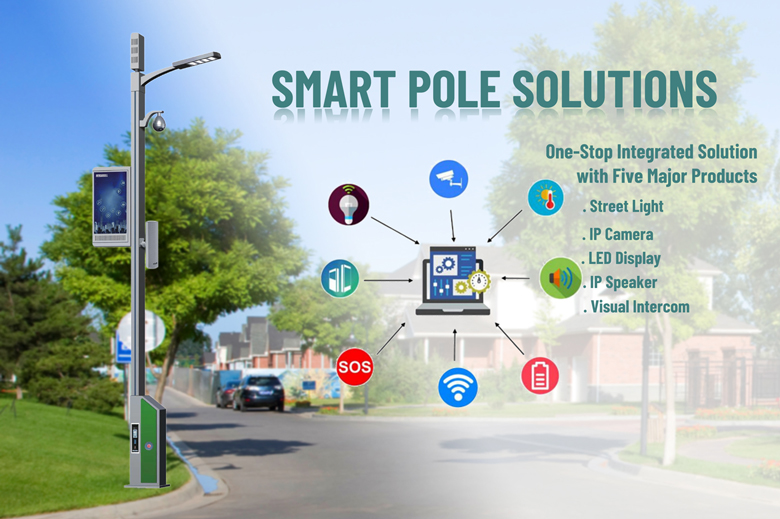

Leave a message

Smart Poles key technologies can be summarized into eight categories: IoT sensing and interaction (intelligent sensing) technology, system interconnection (interconnectivity) technology, edge computing technology, data fusion technology, intelligent decision-making technology, business collaboration technology, digital twin technology, and IoT security technology.

IoT sensing and interaction (intelligent sensing) technology mainly supports the collection, interaction, and interconnection of various types of sensing information for the devices mounted on the smart poles. At the IoT sensing layer, IoT information sensing and multi-modal situational awareness are achieved through interfaces between devices and the platform, intelligent network interfaces, and integrated sensing and execution models.
System interconnection (interconnectivity) technology aims to connect and integrate the dispersed information and data collected and stored by various sensing devices, providing support for information interconnectivity and data sharing and exchange. This technology ensures the interconnection of data, computing power, networks, and platforms across the access convergence layer and network transmission layer. System interconnection technology promotes the construction of interconnected networks, multi-plane networks, and a unified city network through the self-networking of various IoT sensing devices, network devices, and platforms, as well as the connection of systems and platforms.
Edge computing technology is mainly applied at the access convergence layer to perform localized parsing, summarizing, protocol conversion, and collaborative computing processing of the information collected by various sensing devices. This supports real-time data analysis and cloud-edge-end collaborative intelligent decision-making, enhancing the interoperability and dynamic scheduling capabilities of edge computing devices with the cloud and end-side, to meet the collaborative computing power support needs of smart poles.
Data fusion technology is primarily applied at the edge computing service nodes in the access convergence layer or at the platform application layer to standardize the fusion and governance of multi-source heterogeneous data for smart poles. This technology enhances the data mining and knowledge learning capabilities of the devices mounted on smart poles and strengthens their key capabilities in data association, analysis, management, governance, operation, maintenance, and application services, thereby supporting the realization of information aggregation, sharing, exchange, and effective utilization.
Intelligent decision-making technology is mainly applied at the edge computing service nodes in the access convergence layer or at the platform application layer to support smart pole managers in perceiving and analyzing emergency information from the devices mounted on the smart poles. This involves constructing a linkage mechanism with event warning and notifications, information processing, and decision support. Intelligent decision-making technology includes aspects such as emergency perception and modeling, heterogeneous data access, multi-type resource scheduling, decision process representation, and evaluation.
Business collaboration technology aims to connect physical facilities and information resources involved in the planning, construction, and operation management of smart poles. This technology spans the access convergence layer and platform application layer, providing support for integrating and collaborating processes across different business systems involved in smart pole operations.
Digital twin technology is mainly applied at the platform application layer to standardize various data models (data structure, data operation, and data constraints) involved in the planning and construction of smart poles. This technology establishes data models and IoT models in the application domain to guide data fusion and quality improvement for smart poles.
IoT security technology mainly provides support for various sensing devices, system interconnection devices, and platform systems for smart poles, spanning the sensing layer, access convergence layer, network transmission layer, and platform application layer. This technology ensures the integrated security of the hardware and software systems for smart poles. IoT security technology primarily includes aspects such as access security for various devices, communication security for interconnectivity devices, data security, storage security, control security, and electrical safety for power supply and distribution equipment in smart pole systems.
 【DSPPA Demo】PAVA8000 EN54 Voice Evacuation SystemNovember 12, 2020Abstract: DSPPA PAVA8000 EN54 Voice Evacuation SystemToday, we are gonna show you a demo about our PAVA8000 EN54 Voice Evacuation System.PAVA8000EN54 Voice Evacuation System can not only support manua...view
【DSPPA Demo】PAVA8000 EN54 Voice Evacuation SystemNovember 12, 2020Abstract: DSPPA PAVA8000 EN54 Voice Evacuation SystemToday, we are gonna show you a demo about our PAVA8000 EN54 Voice Evacuation System.PAVA8000EN54 Voice Evacuation System can not only support manua...view The National Standard Approval Meeting held in BeijingJuly 19, 2019The National Standard Approval Meeting held in BeijingThe approval meeting of the National StandardTechnical standard of public address system engineeringis held in Beijing on July 16, 2019. Xue Chang...view
The National Standard Approval Meeting held in BeijingJuly 19, 2019The National Standard Approval Meeting held in BeijingThe approval meeting of the National StandardTechnical standard of public address system engineeringis held in Beijing on July 16, 2019. Xue Chang...view